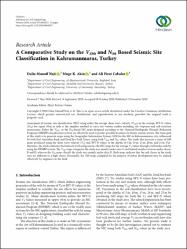A Comparative Study on the VS30 and N-30 Based Seismic Site Classification in Kahramanmaras, Turkey
Abstract
Assessment of seismic site classification (SSC) using either the average shear wave velocity (V-S30) or the average SPT-N values (N-30) for upper 30 m in soils is the simplest method to carry out various studies including site response and soil-structure interactions. Either the V-S30- or the N-30-based SSC maps designed according to the National Earthquake Hazards Reduction Program (NEHRP) classification system are effectively used to predict possible locations for future seismic events. The main goal of this study is to generate maps using the Geographic Information System (GIS) for the SSC in Kahramanmaras city, influenced by both East Anatolian Fault and Dead Sea Fault Zones, using both V-S30 and N-30 values. The study also presents a series of GIS maps produced using the shear wave velocity (V-S) and SPT-N values at the depths of 5 m, 10 m, 15 m, 20 m, and 25 m. Furthermore, the study estimates the bed rock level and generates the SSC maps for the average V-S values through overburden soils by using the NEHRP system. The V-S30 maps categorize the study area mainly under class C and limited number of areas under classes B and D, whereas the N-30 maps classify the study area mainly under class D. Both maps indicate that the soil classes in the study area are different to a high extent. Eventually, the GIS maps complied for the purpose of urban development may be utilized effectively by engineers in the field.


















